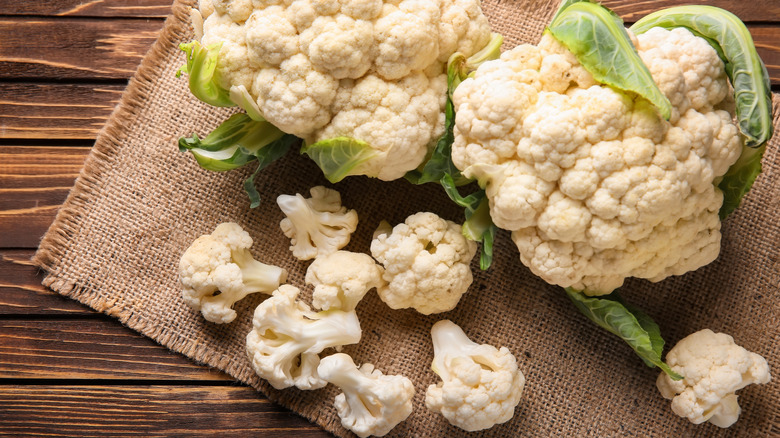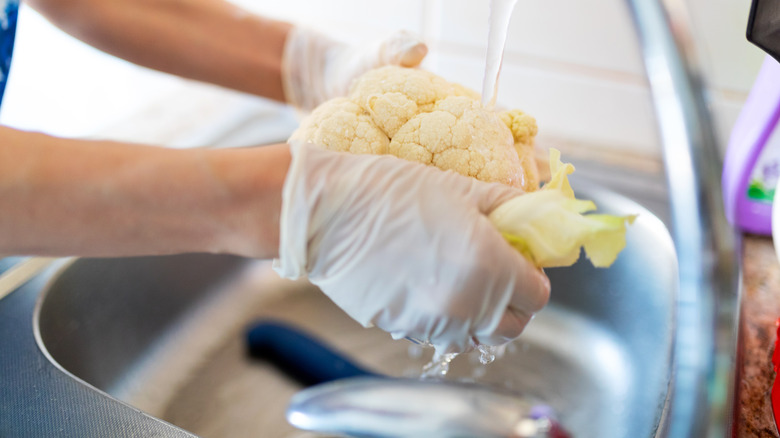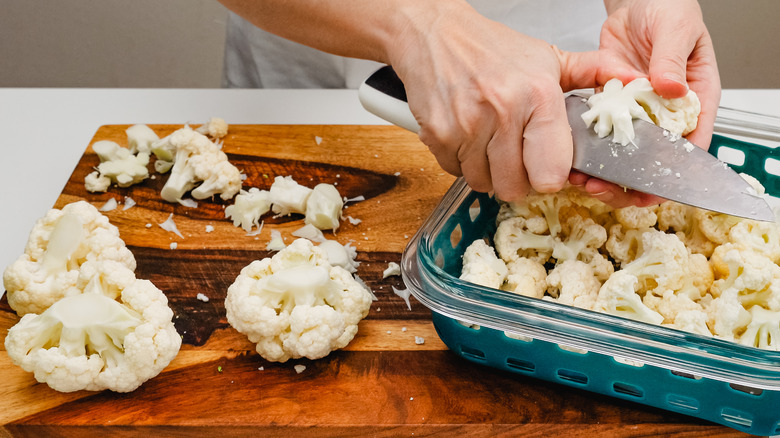How To Deep Clean A Cauliflower With Salt And Vinegar
Washing fruits and vegetables never seemed like rocket science, not until the "correct" way to clean strawberries started making the rounds of social media, at least. As netizens were introduced to the colonies of bugs hiding deep within the berries, water no longer cut it: It was time to start washing fresh produce with salt or vinegar. Much like strawberries, cauliflower tends to be filled with hidden creepy crawlies that water alone may not be able to get rid of, which is why you should consider deep cleaning it with salt and vinegar.
According to a video posted by Tennessee-based Redleaf Ranch on TikTok, you should let your cauliflower sit in a bowl of water mixed with salt and white vinegar for about 10 minutes before you chop and cook it. The salt and vinegar mixture will suck out all the dirt and bugs hidden inside the crevices of the cauliflower and leave you with a clean vegetable that is safe for eating. Once you toss the mucky water out, chop your cauliflower and rinse it in clean water before you get down to cooking it.
Does salt and vinegar really help?
Cauliflowers are naturally filled with crevices and nooks that are perfect hiding spots for dirt, bacteria, and tiny bugs that aren't always visible, which is where salt and vinegar come in. The acid in vinegar has long made it a favorable cleaning agent around the house. A vinegar cleaning solution can remove bacteria, pesticides, microorganisms, and any wax coating on fruits and vegetables. Not to mention that white vinegar is perfectly safe for consumption, making it an excellent liquid to wash edible items with. The same goes for salt: Soaking vegetables like cauliflower in salt water removes pesticides and insecticides and destroys harmful bugs and bacteria.
That said, vinegar or salt isn't always better than water. While Cook's Illustrated's experiments did find that diluted vinegar can kill more bacteria on produce like apples than water, some studies indicate otherwise (via NPR). Experts at Tennessee State University's Institute of Agricultural and Environmental Sciences found that a simple two-minute soak in plain water could get rid of 98% of the bacteria present in produce, including those — like cauliflower — that are filled with crevices.
A 2006 study published in the Journal of Food Protection went on to add that cleaning produce in acidic liquids like vinegar did not significantly reduce surface contamination compared to if they were cleaned with a brush under cold running water, indicating that sometimes, water can be enough to rinse vegetables like cauliflower.
Prep the cauliflower before you clean it
Whether you choose to clean your cauliflower with just water or would prefer to soak it in a mixture of salt, white vinegar, and water as an extra precaution, it's crucial to prep the vegetable before you start cleaning it. To do so, you should first pull off the tough outer leaves that cover the cauliflower and then remove the sturdy stem on the bottom of the vegetable. Next, you should chop the vegetables into smaller pieces that are much easier to clean and get rid of the thick core of the cauliflower.
Once the tough-to-clean parts of the cauliflower have been removed and the vegetable is broken into smaller florets, you can get on to the cleaning part. Rinse the florets in running water to remove dirt, soak them in salt and vinegar water, and rinse them in fresh water again. Alternatively, boil the florets in hot water seasoned with salt for about two minutes. Doing so will remove the bacteria as the cauliflower is blanched, killing two stones in one go. Once the florets have been blanched, transferring them to a bowl filled with ice will immediately stop the cooking process and ensure that the cauliflower remains crispy when cooked. Once that is done, your cauliflower should be clean and ready for cooking.



